Database Data Source
If you selected one of the MS SQL Server, MySQL, PostgreSQL, or SQLite data sources, the next screen of the report wizard allows you to configure the actual connection. The following sections describe the connection settings for each database.
Fixed and Dynamic Settings
Connection settings can either be fixed or dynamic:
- Fixed Settings: These are hard-coded values that remain constant and can only be modified at design-time.
- Dynamic Settings: These allow you to supply values programmatically or interactively, giving more flexibility during runtime or when different users view the report.
To make a setting dynamic, click the Parameter... link near the setting name:

This will open the Parameters dialog:
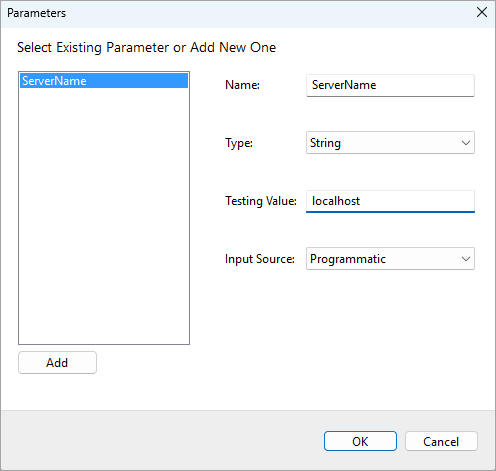
Here, you can re-use an existing parameter or create a new one by clicking the Add button. The following properties can be configured:
- Name: The parameter name used as a reference in the connection settings. You’ll need this name to supply its value via code if you choose to do so.
- Type: The data type of the parameter. You can select from Boolean, DateTime, Integer, Float, and String.
- Testing Value: The value used at design-time to test the connection.
- Input Source: Choose Programmatic to supply the parameter values via your application code, or Interactive to allow report readers to provide the parameter values.
Advantages of Dynamic Settings
Dynamic settings offer flexibility, especially in environments where connection details might change or where different users require different settings. For example, in multi-user applications, parameters can adapt to the current user's credentials or preferences, ensuring the correct data is accessed.
Using Connection String from the Configuration
When you invoke the Report Wizard in Visual Studio to add a new report to an existing project, you have the option to select a pre-configured connection string from the app.config or web.config file. This is particularly useful because it allows the ActiveReports.NET engine to read and use the specified connection string directly from the configuration file when the report runs.
Selecting a Pre-configured Connection String
In the Report Wizard, after selecting your data source (e.g., MS SQL Server), you'll see an option to use a connection string from the configuration file.
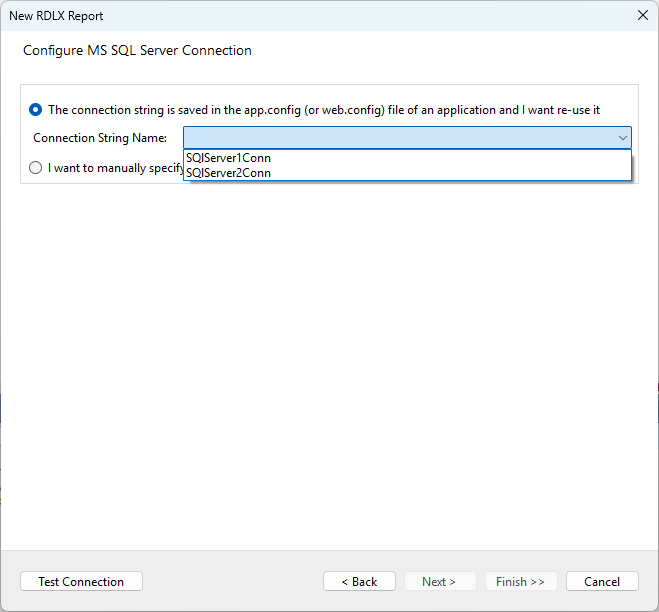
The UI will present a dropdown list of available connection strings saved in your app.config or web.config file.
The ActiveReports.NET engine will use the selected connection string when the report is executed, ensuring that the connection is made using the details stored in the configuration file.
Manual Configuration Option
If you prefer not to use a pre-configured connection string, you can choose to manually specify the connection string and configure the settings by hand, as described below.
Note on Standalone Report Designer
If you are working with the Standalone Report Designer application, please note that the option to select the connection string from the configuration file is not available.
Configuring MS SQL Server Connection
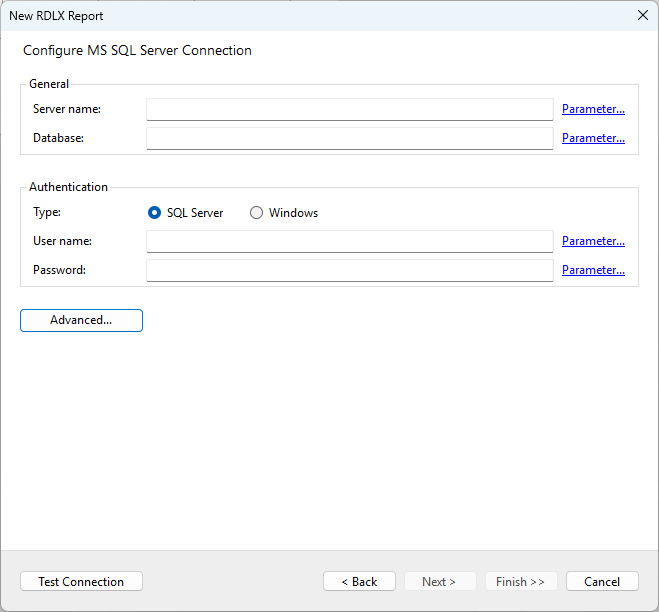
General Settings
- Server Name: Enter the hostname, the IP Address, or the instance name of the SQL Server instance (e.g., ServerName\InstanceName for named instances). You can make the server name dynamic by using a parameter, as described above.
- Database: Specify the name of the database. This can also be set dynamically using parameters.
Authentication Settings
- SQL Server Authentication: If this option is selected, provide the User name and Password for SQL Server login credentials. These can be set as dynamic parameters.
- Windows Authentication: This option uses the credentials of the currently logged-in Windows user.
Advanced Settings
Click the Advanced... button to configure additional options such as connection timeout, network protocol, etc. All advanced settings can also be made dynamic using parameters.
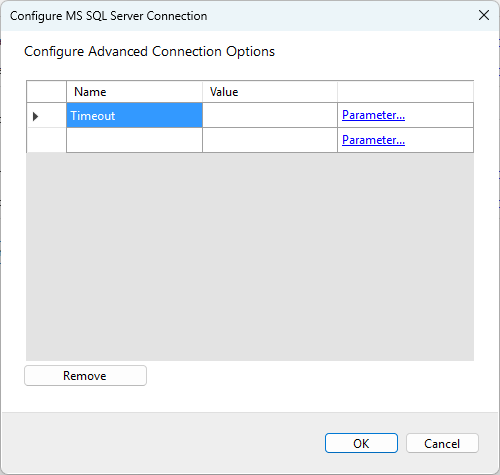
Test Connection
After entering the necessary details, click the Test Connection button to verify that the connection to the SQL Server is successful.
Once the connection is confirmed, click Next > to proceed to the Configure MS SQL Server Queries step of the report wizard.
Configuring MySQL Server Connection
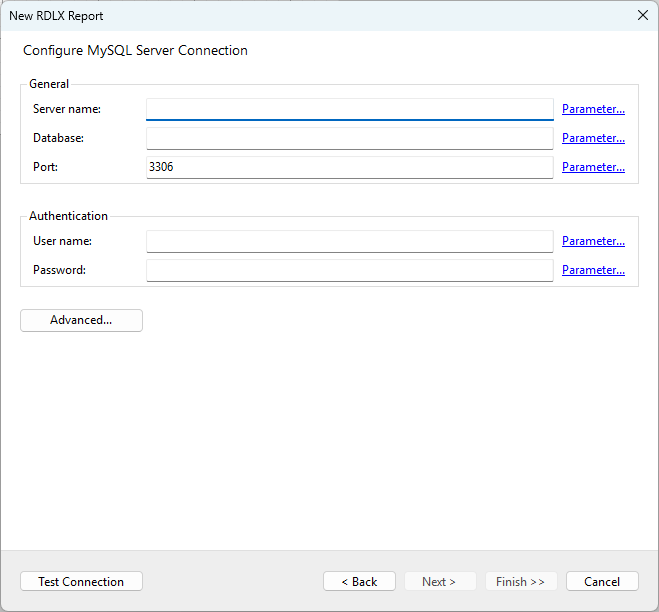
General Settings
- Server Name: Enter the hostname or IP address of the MySQL server. This can be a static value or made dynamic by using a parameter, as described in the Fixed and Dynamic Settings section above.
- Database: Specify the name of the database you wish to connect to. This setting can also be dynamic using parameters.
- Port: The default port for MySQL is 3306. Ensure this is correct or modify it if your MySQL server is configured to use a different port. You can also make the port number dynamic by using a parameter.
Authentication Settings
- User Name: Enter the MySQL username. You can choose to make this dynamic by using a parameter.
- Password: Enter the corresponding password for the MySQL user. This can also be set as a dynamic parameter.
Advanced Settings
Click the Advanced... button to configure additional options such as SSL settings or connection timeout. Just like with the other settings, all advanced options can be made dynamic by using parameters.
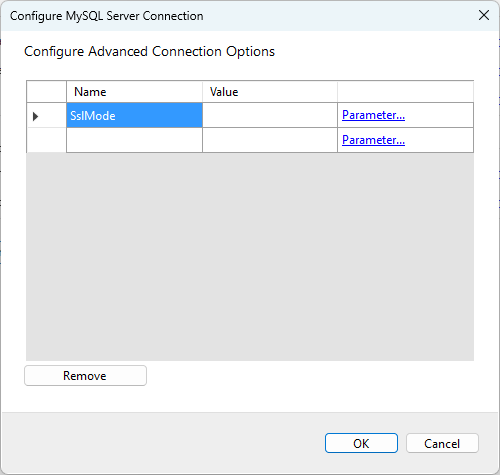
Test Connection
After filling in the necessary details, click the Test Connection button to ensure that the connection to the MySQL server is successful.
Once you've confirmed that the connection is working, click Next > to proceed to the Configure MySQL Server Queries step of the report wizard.
Configuring PostgreSQL Server Connection
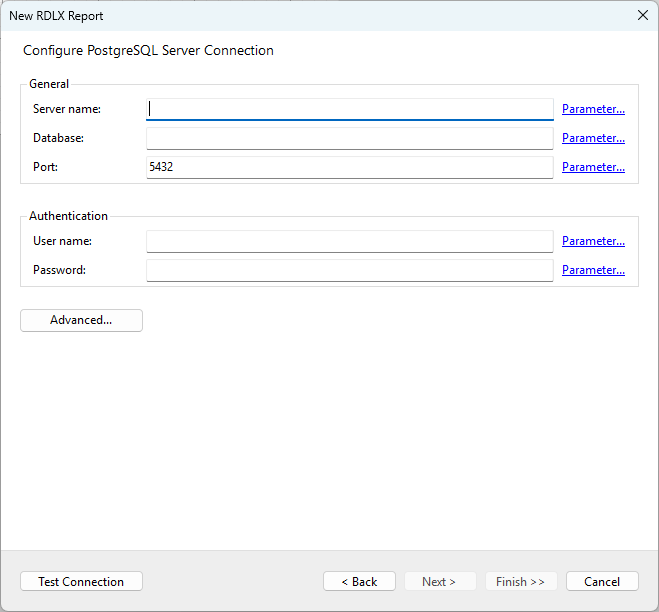
General Settings
- Server Name: Enter the hostname or IP address of the PostgreSQL server. This value can be static or made dynamic using a parameter, as described in the Fixed and Dynamic Settings section above.
- Database: Specify the name of the database you wish to connect to. You can either enter a static value or make it dynamic by using a parameter.
- Port: The default port for PostgreSQL is 5432. Ensure this is correct or modify it if your PostgreSQL server is configured to use a different port. You can also make the port number dynamic by using a parameter.
Authentication Settings
- User Name: Enter the PostgreSQL username. This can be set dynamically by using a parameter if needed.
- Password: Enter the password associated with the PostgreSQL user. This can also be configured as a dynamic parameter.
Advanced Settings
Click the Advanced... button to configure additional options such as SSL settings, connection timeout, or other advanced PostgreSQL-specific options. These settings can also be made dynamic by using parameters.
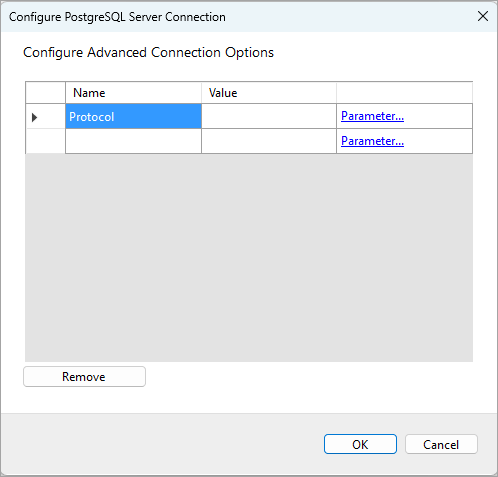
Test Connection
After filling in the necessary details, click the Test Connection button to ensure that the connection to the PostgreSQL server is successful.
Once you've confirmed that the connection is working, click Next > to proceed to the Configure Postgres Server Queries step of the report wizard.
Configuring SQLite Connection
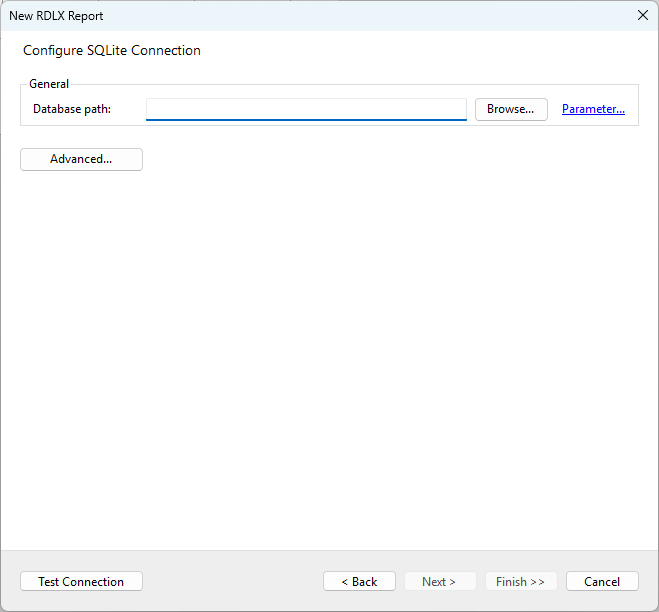
General Settings
- Database Path: Enter the path to the SQLite database file. You can either type the path directly, use the Browse... button to locate the file, or make the path dynamic by using a parameter, as described in the Fixed and Dynamic Settings section above.
Advanced Settings
Click the Advanced... button to configure additional options such as connection timeout, cache size, or other SQLite-specific settings. These settings can also be made dynamic by using parameters.
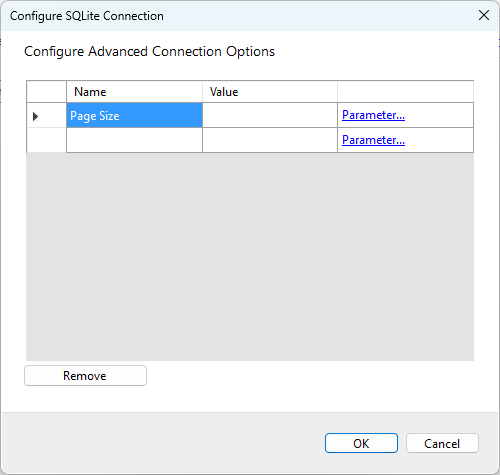
Test Connection
After entering the necessary details, click the Test Connection button to ensure that the connection to the SQLite database file is successful.
Once you've confirmed that the connection is working, click Next > to proceed to the Configure SQLite Queries step of the report wizard.


